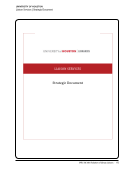68 · Survey Results: Survey Questions and Responses
We have undertaken a year-long assessment of our liaison program, including liaison librarian and faculty focus
groups, and an external review. We are now moving forward to engage with our community to review and adopt
these recommendations.
We revised the basic liaison job description to make it more engagement focused, and also developed functional teams.
We are working on the team contracts and competencies for those functional teams.
We will be developing expectations for our liaisons around support for scholars, scholarly communication, and
data management.
We adopted the Engaged Librarian Framework in 2011.
Yes, we recently expanded beyond traditional, subject-based role to an “engagement team” to include functional
specialists who are essential to the Libraries’ information literacy role as well as capturing, curating, and preserving
campus scholarly output.
28. What were the primary factors that led to making these changes? Check all that apply. N=61
Changing landscape of scholarship and publishing 50 82%
Identification of new needs within the university or parent organization 42 69%
New leadership within the library 32 53%
Changes to the university or parent organization’s strategic plan and goals 25 41%
The addition of new roles or responsibilities within the university or parent organization for library liaisons 17 28%
New leadership within the university or parent organization 11 18%
Other factor 24 39%
Please specify the other factors that led to making changes in liaison roles and responsibilities.
N=24
A wave of retirements within the library offered an opportunity to consider new directions and organization.
Another catalyst, mentioned earlier, is the New Roles for New Times report published by ARL.
As liaisons learn about emerging priorities or new programs within their assigned areas, they share that knowledge and
work together with library managers to determine how to address those.
Changes in the disciplines, changes in accreditation standards, changes in the curriculum
Changing landscape around research services, e.g., GIS and data management
Creation of learning commons
Desire to expand library’s role in teaching, research, and scholarship. Also the scope of liaison work is too broad for one
person to do everything. We have distributed some of the functions across different people.
Federal government regulations for making data publicly accessible
Group’s self-identification of new roles and the desire to document subject librarians current work.
Growth in online learning (at World Campus and all the campuses across the state), improvement in communication
infrastructure to support scholarship and learning
We have undertaken a year-long assessment of our liaison program, including liaison librarian and faculty focus
groups, and an external review. We are now moving forward to engage with our community to review and adopt
these recommendations.
We revised the basic liaison job description to make it more engagement focused, and also developed functional teams.
We are working on the team contracts and competencies for those functional teams.
We will be developing expectations for our liaisons around support for scholars, scholarly communication, and
data management.
We adopted the Engaged Librarian Framework in 2011.
Yes, we recently expanded beyond traditional, subject-based role to an “engagement team” to include functional
specialists who are essential to the Libraries’ information literacy role as well as capturing, curating, and preserving
campus scholarly output.
28. What were the primary factors that led to making these changes? Check all that apply. N=61
Changing landscape of scholarship and publishing 50 82%
Identification of new needs within the university or parent organization 42 69%
New leadership within the library 32 53%
Changes to the university or parent organization’s strategic plan and goals 25 41%
The addition of new roles or responsibilities within the university or parent organization for library liaisons 17 28%
New leadership within the university or parent organization 11 18%
Other factor 24 39%
Please specify the other factors that led to making changes in liaison roles and responsibilities.
N=24
A wave of retirements within the library offered an opportunity to consider new directions and organization.
Another catalyst, mentioned earlier, is the New Roles for New Times report published by ARL.
As liaisons learn about emerging priorities or new programs within their assigned areas, they share that knowledge and
work together with library managers to determine how to address those.
Changes in the disciplines, changes in accreditation standards, changes in the curriculum
Changing landscape around research services, e.g., GIS and data management
Creation of learning commons
Desire to expand library’s role in teaching, research, and scholarship. Also the scope of liaison work is too broad for one
person to do everything. We have distributed some of the functions across different people.
Federal government regulations for making data publicly accessible
Group’s self-identification of new roles and the desire to document subject librarians current work.
Growth in online learning (at World Campus and all the campuses across the state), improvement in communication
infrastructure to support scholarship and learning












































































































































































































